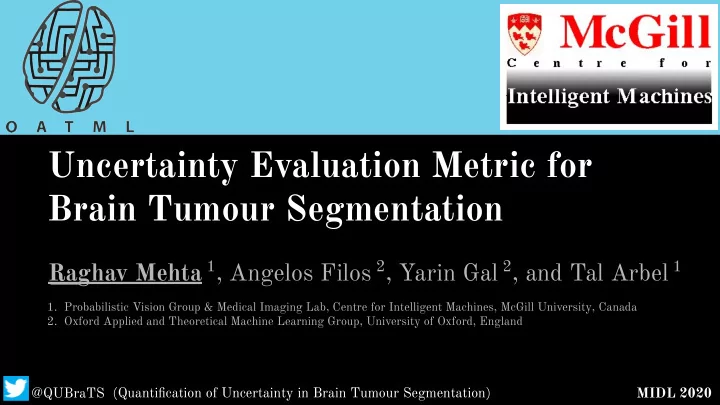

Uncertainty Evaluation Metric for Brain Tumour Segmentation Raghav Mehta 1 , Angelos Filos 2 , Yarin Gal 2 , and Tal Arbel 1 1. Probabilistic Vision Group & Medical Imaging Lab, Centre for Intelligent Machines, McGill University, Canada 2. Oxford Applied and Theoretical Machine Learning Group, University of Oxford, England @QUBraTS (Quantification of Uncertainty in Brain Tumour Segmentation) MIDL 2020
Brain Tumour Segmentation ● Automatic tumour segmentation is of clinical importance ○ Diagnose and staging ○ Outcome prediction ○ Surgical planning (1) @QUBraTS
Brain Tumour Segmentation ● Automatic tumour segmentation is of clinical importance ○ Diagnose and staging ○ Outcome prediction ○ Surgical planning ● Deep learning models outperform other methods on popular MICCAI BraTS (brain tumour segmentation) challenge Ronneberger et. al., MICCAI 2015; Cicek et. al., MICCAI 2016; Kamnitsas et. al., MedIA 2016, BrainLes 2016; Isensee et. al., BrainLes 2018; Havaei et. al., MedIA 2017 (1) @QUBraTS
Brain Tumour Segmentation ● Automatic tumour segmentation is of clinical importance ○ Diagnose and staging ○ Outcome prediction ○ Surgical planning ● Deep learning models outperform other methods on popular MICCAI BraTS (brain tumour segmentation) challenge ● Tumour Segmentation problem is hard: ○ Large variability in size, shape, position; ○ Subtle boundaries, tumours look like other structures; ○ Sub-tissues can be small (e.g. enhancements); Ronneberger et. al., MICCAI 2015; Cicek et. al., MICCAI 2016; Kamnitsas et. al., MedIA 2016, BrainLes 2016; Isensee et. al., BrainLes 2018; Havaei et. al., MedIA 2017 (1) @QUBraTS
Brain Tumour Segmentation ● Automatic tumour segmentation is of clinical importance ○ Diagnose and staging ○ Outcome prediction ○ Surgical planning ● Deep learning models outperform other methods on popular MICCAI BraTS (brain tumour segmentation) challenge ● Tumour Segmentation problem is hard: ○ Large variability in size, shape, position; ○ Subtle boundaries, tumours look like other structures; ○ Sub-tissues can be small (e.g. enhancements); ● Deep learning models can make mistakes! Whole Tumour Segmentation Ronneberger et. al., MICCAI 2015; Cicek et. al., MICCAI 2016; Kamnitsas et. al., MedIA 2016, BrainLes 2016; Isensee et. al., BrainLes 2018; Havaei et. al., MedIA 2017 (1) @QUBraTS
Segmentation of Brain Tumours - Uncertainty ● Errors in results of machine learning algorithms for segmentation of brain tumours can lead to ○ distrust by clinicians, ○ hesitation in inclusion of machine learning models into clinical workflow (2) @QUBraTS
Segmentation of Brain Tumours - Uncertainty ● Errors in results of machine learning algorithms for segmentation of brain tumours can lead to ○ distrust by clinicians, ○ hesitation in inclusion of machine learning models into clinical workflow ● Uncertainty defining confidence in results permit clinical review - bring clinician into the workflow Uncertain Class (2) @QUBraTS
Segmentation of Brain Tumours - Uncertainty ● Errors in results of machine learning algorithms for segmentation of brain tumours can lead to ○ distrust by clinicians, ? ? ?? ○ hesitation in inclusion of machine learning models into clinical workflow ● Uncertainty defining confidence in results permit clinical review - bring clinician into the workflow Uncertain Class ● Bayesian Deep Learning is useful for getting uncertainty 1,2,3 1 Gal and Ghahramani, “Dropout as a Bayesian approximation: Representing model uncertainty in deep learning.”, ICML 2016. 2 Kohl et al., “A probabilistic u-net for segmentation of ambiguous images.”, NeurIPS 2018. (2) 3 Lakshminarayanan et al., “Simple and scalable predictive uncertainty estimation using deep ensembles.”, NeurIPS 2017. @QUBraTS
Uncertainty Analysis: Clinical Adoption Goal: Uncertainty to enable clinicians, radiologists, surgeons to focus on reviewing the most uncertain predictions and trusting the most confident predictions (3) @QUBraTS
Uncertainty Analysis: Clinical Adoption Goal: Uncertainty to enable clinicians, radiologists, surgeons to focus on reviewing the most uncertain predictions and trusting the most confident predictions ● Uncertainty metric must have the following properties: Confident predictions Correct predictions Incorrect predictions Higher Uncertainties (3) @QUBraTS
Quantification of Uncertainty for BraTS ● Compute the uncertainty of a model at each voxel (4) @QUBraTS
Quantification of Uncertainty for BraTS ● Compute the uncertainty of a model at each voxel ● Filter most uncertain voxels, calculate the metric of interest (e.g. Dice ) on the remaining one. Should Improve! (4) @QUBraTS
Quantification of Uncertainty for BraTS ● Compute the uncertainty of a model at each voxel ● Filter most uncertain voxels, calculate the metric of interest (e.g. Dice ) on the remaining one. Should Improve! ● Not at the expense of filtering out correct predictions! ○ Penalize methods for higher filtering of correct predictions. (4) @QUBraTS
Benchmark Results (Entropy - whole tumour) 3D U-Net architecture 1 ● Brain Tumour Segmentation (BraTS) 2019 2 Training set (335): ● Performances of whole tumour segmentation with the Entropy uncertainty measure 3 ● ● Comparison of various uncertainty generation methods: MC-Dropout 4 ○ Deep Ensemble 5 ○ Dropout Ensemble 6 ○ ○ Bootstrap ○ Bootstrap Ensemble 1. Cicek et al., MICCAI 2016 4. Gal and Ghahramani, ICML 2016 2. Bakas et al., arXiv:1811.02629, 2018 5. Lakshminarayanan et al., NeurIPS 2017 (5) @QUBraTS 3. Gal et al., ICML 2017 6. Smith and Gal, arXiv:1803.08533
Thank You @QUBraTS
Recommend
More recommend